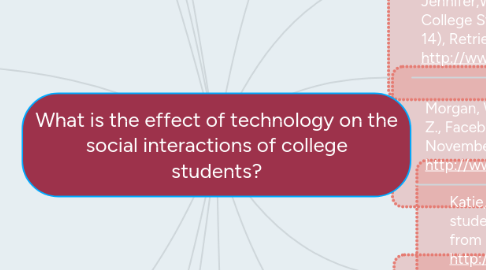
1. No longer are we limited to heavy physical books and textbooks that contain from 1 to several 100’s of pages. Now we have the eBook (electronic book) that provides us with every book we wish to carry at once in the back of our pocket.
1.1. School
1.1.1. This making students less physically social, or face to face interaction, but still allowing students to social throughout the internet. They can share their online annotations instead of bringing their books and papers to class.
1.2. Reading
2. Bullying
2.1. No longer is bullying limited to the classrooms, hallways, bathroom & stair cases in the college which a student attends. Through technology it is everywhere 24/7.
2.1.1. The main ideas of this source are that Cyberbullying affects students emotionally and psychological states. The main argument is that cyberbullying will continue to grow while technological networking grows as well. The easier it is to transfer data the faster it is to harm someone online. This making people who are being target unsocial because now people who did converse with them before, won't anymore because they don't want to be apart of it. Moreover, this leading to suicides and depression.
2.1.2. The author provides this information with logical knowledge and discussing suffering experiences of people who have been bullied through social media/ online in general.
3. Depression
3.1. Depression is universal with or without technology but, What can technology do to help in the fight depression? (Examples: Raise awareness of depression, discover a recourse, social connectivity
3.1.1. The author’s main idea is that many College students are depressed due to interaction through social media such as facebook. They begin to express their depression throughout facebook however, don’t want to admit it in real life. This making them depressed an unwilling to express their feelings outside of the use of technology networking.
3.1.2. In this article, they used chi-square tests to assess differences between depression displayers and non-displayers. This then showing that more college students 18.5 years old being displayers throughout Facebook. This also being ethos a source of credibility that studies have been found that teenagers are less social to people outside of the internet. Whereas, the internet allows them to express their inner feelings and struggles. This leading people to become antisocial and mentally not okay.
4. Communication
4.1. Social Media
4.1.1. Facebook: Connect with friends and family, where you could share your personal life
4.1.1.1. The author’s main idea is that social media such as facebook, twitter and Instgram have made people insecure about how they look and feel about themselves. There is a physical appearance comparison on how people want women/men to look. Therefore, making people have self-doubt and leading to disordered eating. College women begin “dieting” due to fat talk on facebook.
4.1.1.2. Through an online survey, this group using credibility as well to guarantee that college students indeed are facing social problems due to what they see on Facebook. Social Media is effecting college students interactions because now they don't feel physically/mentally comfortable with how they look.
4.1.2. Twitter: Blog that allows to easily post thoughts, ideas and/or daily activities.
4.1.2.1. Instagram: Quickly share photos between friends and family.
5. Crime
5.1. Technology comes with various benefits but, with each step that are lives become more involved with technology… we pave the road for technology to be utilized against us for a new wave of ‘cyber’ crime.
5.1.1. The author’s main idea is that the more use of technology and its advancements leads to more crimes such as drug deals, money theft, identity theft, and hackers. In addition, this affecting college students who everyday use there information on their computers. This making people more socially interactive throughout phone calls, texting.. However, this is a way to interacte negatively because now people can transfer information fast. Easier access to people information , a text is the easiest thing to send and a phone call.
5.1.2. This study using ethos because they have done a study and found that many people have been using phones, computers and digital communication for socially crime purposes.
5.1.2.1. This study being different from the others because it shows a different way that college students can socially interact and how technology can effect students in this case being bad.
6. Family
6.1. Now with technology families and couples could easily stay in touch with their cellphones, computers (portable, desktop) and tablets.
6.1.1. This making college students feel safer because they have their families just a call away... For example, I have a lot of family overseas however, I don't feel the urge to go every year to visit because i can interact with them through technology. In addition, this also being a good use for college students who are dorming at their University. This also students to still interact with their families through phone calls, social media, or texts. Technology benefiting college students who travel far distances from home.
7. Virtual Life
7.1. Second Life
7.1.1. Through technology physical interactions are no longer necessary where it allows people to live a virtual life online and even allow college students to attend their classes and complete lab work online. This making life easier for school students.
7.1.1.1. Also, there are online game sites, such as Habbo. Where you feel as though you are living a real life through making your character and making online friends. You can create your own house and you have to buy coins. This can also lead to students getting attached. People begin to make relationships with others and can end badly because people get attachment anxiety through technology.
7.1.1.2. This author, using logical information to persuade the reader that technology benifits college students. As well as, credibility because their were surveys done to see which colleges have virtual learning and allowing people to interact online rather then in person.
